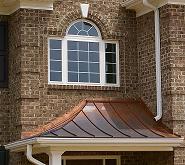Copper Roof & Aluminum Eavestrough | Understanding Galvanic Corrosion
Selecting the Right Eavestrough Material
When choosing an eavestrough material, it is essential to consider the risk of Galvanic or Electrolytic Corrosion that can occur when dissimilar metals come into contact, particularly in environments with high moisture, pollution, or coastal exposure. Understanding these risks will help in selecting the most durable and compatible materials for long-term performance.

What is Galvanic Corrosion?
Galvanic corrosion occurs when two dissimilar metals are in contact in the presence of an electrolyte, such as rainwater or high humidity. The electro-positive (anodic) metal will corrode, while the electro-negative (cathodic) metal remains more corrosion-resistant. The greater the difference between the two metals on the galvanic scale, the faster and more severe the corrosion.
Preventing Galvanic Corrosion
To minimize the risk of galvanic corrosion, consider the following precautions:
- Avoid Direct Contact Between Dissimilar Metals – Choose materials that are closer together on the galvanic scale to reduce reaction potential.
- Limit Small Exposed Areas of Anodic Metal – Avoid using small anodic fasteners (e.g., aluminum nails) on cathodic surfaces like copper.
- Apply Protective Coatings – Use a non-metallic coating such as zinc chromate or bituminous coatings to insulate metals from each other.
- Use Non-Conductive Barriers – Install gaskets, tape, waterproof paper, or elastomeric sheets to physically separate the metals.
- Prevent Water Runoff from Copper onto Aluminum – Ensure proper drainage design to avoid water flowing from copper surfaces onto aluminum components.
- Regular Maintenance – Remove any metal debris from steel dies on aluminum surfaces to prevent unintended deposits that accelerate corrosion.
Miscellaneous Considerations About Corrosion
- Passivated Stainless Steel – Chemically treated stainless steel is more corrosion-resistant.
- Anodized Aluminum Compatibility – Anodized aluminum is more resistant to galvanic reactions with other metals.
- Salts in Water – Higher salt content increases the conductivity of water, accelerating corrosion.
- Drainage from HVAC Units – Condensation from air conditioning systems containing copper pipes can cause severe corrosion when draining onto galvanized steel or aluminum surfaces.
- Fastener Selection – Using copper nails on galvanized steel can cause premature failure, while using galvanized steel fasteners on copper can rapidly corrode the fasteners.
Q&A: Copper Roofing with White Aluminum Eavestrough
Question:
I have a porch and bay roof that we plan to replace with copper. Since the trim below the copper roof is white, we were considering white aluminum eavestroughs to match. Some vendors suggest corrosion will occur over time, while others say it shouldn’t be an issue. What is your recommendation?
Answer:
When dissimilar metals like copper and aluminum are in contact in the presence of an electrolyte (such as rainwater), a galvanic reaction will occur. Copper, which is higher on the galvanic scale, will attract electrons from aluminum, causing the aluminum to corrode. Even airborne moisture can trigger this reaction, and once it starts, it is difficult to stop.
If rainwater flows over the copper roof and into the aluminum eavestrough, the water will act as an electrolyte, accelerating the corrosion of the aluminum. Over time, the aluminum may develop stains and start deteriorating. The exact timeline varies depending on environmental factors, but degradation could begin within a year or last up to ten years.
The same issue occurs with galvanized steel eavestroughs, as they also react negatively to copper runoff. To prevent corrosion, consider alternative materials such as:
- Copper Eavestroughs – Ideal for compatibility but more expensive.
- Copper-Clad Stainless Steel – Provides strength and corrosion resistance.
- Terne-Coated Stainless Steel – A durable and compatible option.
- Bare Stainless Steel – Offers corrosion resistance without reacting to copper.
- High-Quality Plastic Eavestroughs – Non-reactive and available in various finishes.
Final Recommendation
For longevity and reduced maintenance, copper eavestroughs are the best match for a copper roof. If aesthetics and budget constraints require aluminum eavestroughs, ensure proper separation with a protective barrier or coating. Otherwise, opt for stainless steel or high-quality plastic alternatives to avoid long-term corrosion issues.
Need Expert Advice? Contact Maxima Aluminum for tailored recommendations and high-quality roofing and eavestrough solutions!
📞 Call Now: [416-875-6366]
📧 Email Us: [info@maxima-aluminum.com]
🌐 Visit Our Website: www.maxima-aluminum.com

